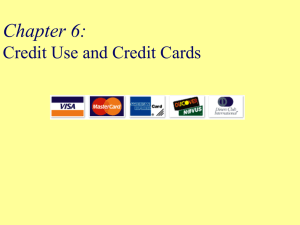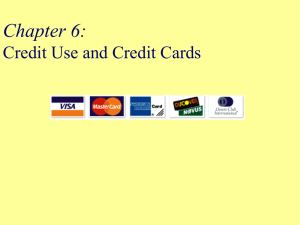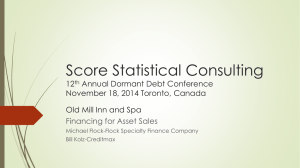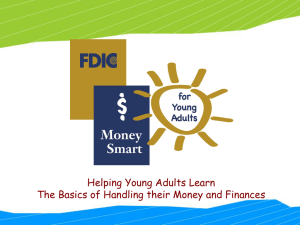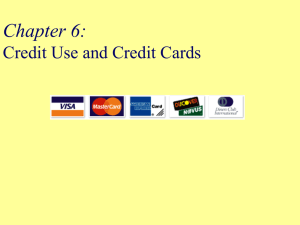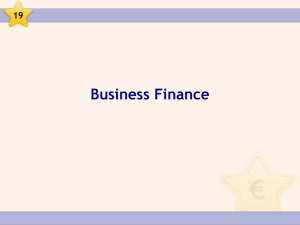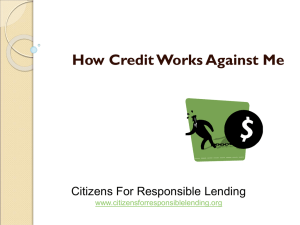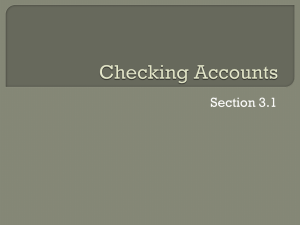Module 2
advertisement
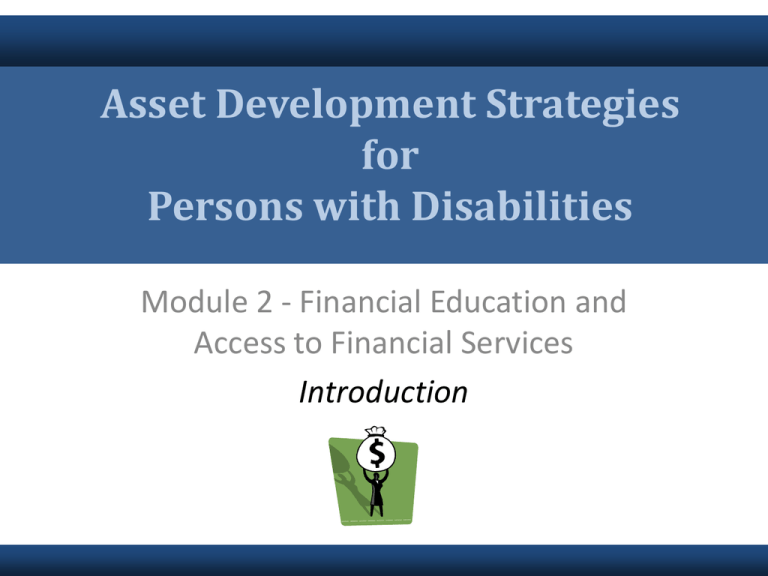
Asset Development Strategies for Persons with Disabilities Module 2 - Financial Education and Access to Financial Services Introduction Module 2 • Welcome to our second session of Asset Development Strategies. Today, we will focus on the importance of financial education and access to banking. • To start us on the right path, I want you to answer two questions to test your knowledge about managing money. Question 1 • Which of these statements are true about savings accounts? They are very risky. b) They are not very risky. c) They require a $1000 minimum balance. d) They are not accessible via ATM withdrawals. a) Question 2 You go to a store to purchase an item but don’t have the cash to pay for it. Which payment method will likely cost you the least amount of money? Purchasing the item with a credit card. b) Obtaining a bank loan to cover the cost of the item. c) Relying on overdraft protection to cover the difference. d) Saving up for the item by putting money in an interest bearing savings account. a) • Which of these statements are true about savings accounts? They are very risky. (23%) b) They are not very risky. (30%) c) They require a $1000 minimum balance. (18%) d) They are not accessible via ATM withdrawals. (29%) a) • You go to a store to purchase an item but don’t have the cash to pay for it. Which payment method will likely cost you the least amount of money? a) b) c) d) Purchasing the item with a credit card. (47%) Obtaining a bank loan to cover the cost of the item. (11%) Relying on overdraft protection to cover the difference. (8%) Saving up for the item by putting money in an interest bearing savings account. (34%) Financial Education • Financial Education is about making informed decisions that are in your own best economic interest. It is about understanding the difference between paying cash and using a credit card, which will cost you money in interest payments if you do not pay your full credit charges each month. • It is about creating a budget and setting savings and asset goals. Module 2 • A recent study by the Federal Deposit Insurance Corporation (FDIC) found that 80 percent of all Americans needed very basic financial education and only 10 percent needed none. • There are costs to not having a savings and/or checking account. Families with incomes under $20,000 per year spend an average of $500 per year to get a check cashed or pay bills. The same services at a bank would cost between $30 and $60 per year. • In 2005-2006, the Internal Revenue Service (IRS) and the National Disability Institute conducted research which found that an estimated 30% to 50% of people with disabilities do not have a savings or checking account. Homework Review 1. 2. 3. 4. 5. 6. 7. 8. My Trip to the Bank Was there a minimum dollar amount to open a checking account? What are the costs to you per month to have the account? Was there a minimum dollar amount to open a savings account? Are there monthly service costs to you? Do either the checking or savings account pay you interest on the money in your account? Do you have to maintain a minimum balance? Were you asked to apply for a credit card? Were you offered an ATM card and were you given information about service fees? Asset Development Strategies for Persons with Disabilities Module 2 - Financial Education and Access to Financial Services Overview, Purpose, and Expected Outcomes Module 2 The training today will focus on financial literacy and access to mainstream financial services. • Financial literacy is the ability to make informed judgments and effective decisions regarding the use and management of money. • Financial education programs cover a range topics to help you manage your money, save, and build assets. Examples of Financial Education Topics • Creating a budget • Managing money • Understanding efficient use of credit • Avoiding high interest rates with credit or a • • loan Avoiding fraud and protecting your money Becoming an educated consumer of financial services Module 2 • The session today has three objectives: 1. Improve understanding of the importance of financial education, access to financial services that minimize costs and opportunities to save and build assets; 2. Become more aware of what financial education programs offer and where to find them; and 3. Better understand the difference between mainstream financial institutions and check cashing stores that charge higher fees. Asset Development Strategies for Persons with Disabilities Module 2 - Financial Education and Access to Financial Services Main Presentation Module 2 • In today’s world, managing the money you earn from work is not easy. • You have many decisions to make and many choices as to what to do with the money you earn. Module 2 • Financial education, like learning how to read or write, is about learning important skills you will use every day to make important, informed decisions about your personal financial situation. Module 2 • Financial education programs will help you understand the management of money you earn. • Financial management is about a series of decisions related to setting • • • • financial goals, creating a budget and spending plan, effective use of credit and continued review and refinement of your goals and strategies to achieve a better economic future. Module 2 • A better economic future is not just defined by your employment status in terms of where you work and how much you are paid. • A better economic future will result from setting savings and asset building goals that improve your quality of life, expand choices for you and enhance opportunities for community participation. Why do people with disabilities need financial education? • If you rely only on public benefits, and live from benefit check to benefit check each month, it is important to develop skills to set a budget and have a spending plan. • If you are working even part-time, you have decisions to make about spending within a budget and setting savings goals. • With the right support and education, you can learn more about managing money, setting goals, and building assets. What organizations provide financial education? • Financial Institutions Banks o Credit Unions o • Community Colleges • Consumer Credit Counseling Service • Other community nonprofit groups Money Smart • In 2001, the Federal Deposit Insurance Corporation launched a national financial education program called Money Smart. • The purpose of Money Smart is to provide money management skill-building and create positive relationships with banks. • Money Smart has ten modules that take between one and two hours to complete. Money Smart Modules 1. 2. 3. 4. 5. Bank On It – covers types of insured financial institution, types of accounts, and the differences between checkcashing businesses and banking institutions. Borrowing Basics – covers loans and credit. Check It Out – covers the ins and outs of a checking account and its features. Money Matters – covers the benefits and how-to’s of saving. Pay Yourself First – covers ways to save money. Money Smart Modules 6. 7. 8. 9. 10. Keep It Safe – covers laws that protect banking consumers and shows how to protect your money. To Your Credit - covers the ins and outs of credit reports and repair. Charge It Right – covers the basics of credit card use. Loan To Own – covers the types of installment loans and how to pick the best loan for your needs. Your Own Home – covers the merits of owning a home over renting and steps to take to prepare for homeownership. Money Smart • Money Smart is available in Braille and larger • print. An online version is available on the FDIC website: www.fdic.gov/consumers/consumer/moneysmart/ Module 2 • To change a pattern of spending or cashing your check from work at a check cashing store is not easy. • Changing financial behavior requires thinking about the consequences of not following a spending plan and having no savings plan. Rule Number One: Pay Yourself First! Module 2 • What would happen if each month before you paid your list of bills for food, rent, and other things, you first paid yourself $12.50 per week or $50 for the month? • If the $12.50 per week were put in a savings account you would earn additional dollars depending on the best interest rate you could find for a savings account. • Deposit $12.50 per week for 10 years in a piggy bank in your house and you will accumulate $6,000. • Deposit $12.50 per week for 10 years in a savings account in a bank or credit union at 4.5 percent interest and you will accumulate at least $7,500 or $1,500 more. “Pay yourself first” is the secret to financial independence. Module 2 • Competition in the financial services industry has dramatically increased the variety of products offered to you and other potential customers. • There are more non-bank providers of financial services than ever before. You have choices to make. What questions do you want to ask of a financial service provider? Questions to Ask 1. Do you charge a fee for each transaction (cashing a check, using an ATM, writing a check, writing a check with insufficient funds in your account)? 2. Do you offer any incentives for savings (match your savings, no fees, interest rate higher for first six months)? 3. Do you offer no-fee or low-fee checking accounts (any limits on checks you can write per month or requirements of a minimum balance)? 4. Is my money insured so I am protected if the bank has losses or closes its business? Use of Credit • Many individuals and families have difficulty managing credit. • Credit is the use of funds from a financial service provider. Credit may be extended to you by a loan with specific terms and conditions to purchase a car, a house, or a consumer product like a computer. Use of Credit • Credit may also be extended to you with a credit card which allows you to make purchases at most stores. You will receive a monthly statement that indicates what you bought and how much you owe. • The statement will also indicate a minimum amount due without additional interest payments. • Without paying monthly, you will incur debt and additional interest costs at a high rate. Credit • An individual’s credit history will have a major impact on the ability to borrow money at the more reasonable interest rates or at all. • Without a good credit history based on regular on-time bill payments, it is unlikely you will be able to borrow money at reasonable rates to build assets (purchase a home, start a business, or purchase a computer). What is a Credit Report: Why is it Important? • There are several companies that collect information from banks, retail stores, tax authorities and landlords. They use the information to create a credit report which provides a history of your financial transaction experiences. • Your credit history and credit score will tell potential lenders and creditors whether you are likely to pay your bills on time. Credit Reporting Companies • There are three national consumer credit reporting companies: • • • • Equifax TransUnion Experian These companies have credit history files on almost every adult in the US. Your credit history shows whether you make late payments on credit card bills and to other creditors with whom you have a financial relationship. Credit History • A good credit history will help you get loans, purchase a car, home, or other larger cost consumer products, or may even impact whether an employer will hire you. • Your credit history and credit score is a financial profile that will impact your ability to plan and achieve a better economic future. Credit Score • The higher the credit score, the more success you will have with a potential lender. • • • Scores between 720-850 will indicate to a lender that you have a strong, positive credit history and represent a low risk of not paying your bills on time. Scores between 350-619 indicate you have had problems in managing your bills and debt. You may have great difficulty securing a credit card or loan. The better the score, the greater the possibility you will receive better terms (lower interest rates) on a loan. The Three C’s of Credit • Character – reliable to pay your debts on time? • Capital – valuable assets to repay debt if needed? • Capacity – current job and income production? Consumer Credit Counseling • There are consumer credit counseling agencies that can help you with debt repayment plans when interest on debt is causing you to fall further behind on payments. • Your homework assignment was to read about National Foundation for Credit Counseling. Credit Card 1. 2. 3. 4. 5. Do you have a credit card? Have you ever had problems with paying the monthly bill? If yes, what did you do? Who did you have assist you in reducing your debt? What did you learn from the experience? After the break, we are going to hear from two guest speakers. We will learn more about services offered from a credit counseling program and a financial institution. Asset Development Strategies for Persons with Disabilities Module 2 - Financial Education and Access to Financial Services Exercise Why do people with disabilities need a bank account? • Cash checks without service fees • Pay bills • Protect resources (security) • Save and grow assets Who can help you become a “saver”? • Many banks and credit unions offer different products and services to help you set savings goals and open a savings account. • “America Saves” is a national program of the Consumer Federation of America to help people get in the habit of saving. Virginia Saves Virginia Saves is a part of “America Saves” which is a national program of the Consumer Federation of America to help people get in the habit of saving. www.virginiasaves.org Activity • • • • • Does anyone have a savings plan or goals? Do you save a certain amount of money per week or month? Do you have a specific asset goal? What is it? Are your savings in an account with a financial provider? Do you earn interest on your savings? REMEMBER Rule Number One: Pay Yourself First!
